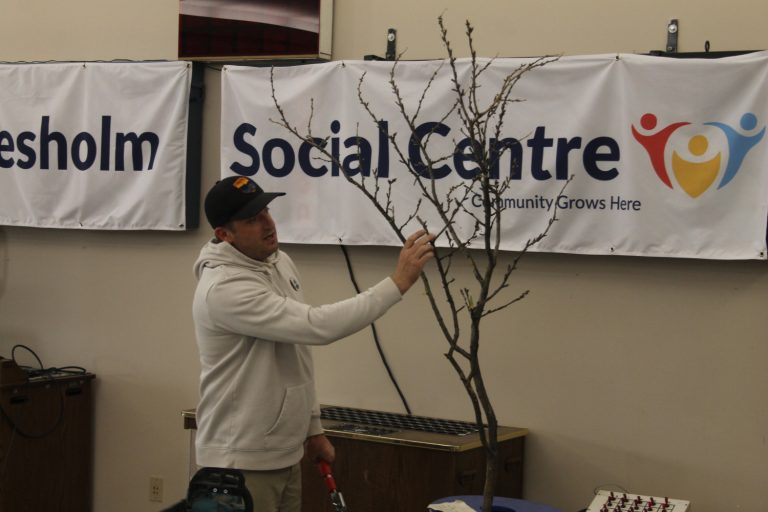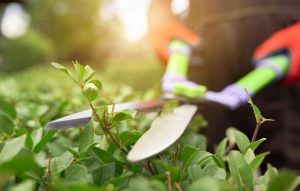Gardeners learn about pruning trees
By Rob Vogt
It was a crash course in pruning trees that provided a lot of useful information.
Arborist Jordie Bronson discussed the ins and outs of pruning trees with the 35 or so people who gathered at the Claresholm Social Centre for the first in a gardening series on Tuesday, March 25, co-hosted by the Town of Claresholm recreation department and the social centre.
He explained trees are pruned to improve tree heath and safety; enhance aesthetics; control size and shape; increase fruit production; and remove dead or diseased wood.
Bronson then went over basic tree biology. The structure of a tree is the roots; trunk; branches; leaves; and crown.
He then described photosynthesis. Trees, like all plants, perform photosynthesis, a process where they convert sunlight, water and carbon dioxide into sugars, that is food, and release oxygen as a byproduct. This process is essential for their survival and growth, as well as for maintaining the Earth’s atmosphere.
The tree also has growth rings.
Tree rings, or annual growth rings, form as trees grow, with each ring representing one year of growth, due to seasonal changes in the rate of cell division in the cambium layer, a region just beneath the bark.
The cambium layer is the real, active part of the tree and it is where the new wood and bark are produced annually.
Bronson then turned his attention to pruning techniques.
He started with the heading cut, which is used to remove dead, damaged or diseased branches; decrease height; shape the plant; increase density; and direct new growth.
A heading cut is made by making the cut just above a bud or lateral branch, about one-quarter inch above the bud.
A thinning cut removes an entire branch at its point of origin on the trunk of a tree or on another branch.
Thinning cuts are used to open up the canopy; maintain natural shape; improve air circulation; promote growth; and strengthen the tree.
A reduction cut reduces the size of a tree or shrub to control the height or shape. Its benefits are the cut reduces the overall size of the tree; helps improve the structure; and helps to reduce the risk of wind damage.
Bronson then talked about how to make a clean cut. He explained it is at a 45-degree angle, sloping away from the bud. Make the cut just outside the branch collar, ensuring you don’t damage or remove the collar. Use sharp pruning tools, such as shears, loppers or saws, to make a clean cut, which promotes faster healing and prevents damage to the tree’s tissues.
Pruning tools include pruning shears; loppers; a pruning saw; pole saw; and chainsaw.
Bronson emphasized the need to sanitize pruning tools.
He explained pruning tools can spread diseases and pathogens from one plant to another.
Before sanitizing, remove any loose dirt or debris from the tools with water.
Wipe or dip the tools in sanitizer, and allow the tools to remain in contact with the sanitizer for the recommended time, such as 10 minutes for bleach.
If using bleach solution, rinse the tools thoroughly with clean water to remove any residue.
Allow the tools to air dry or wipe them clean.
Bronson then discussed when to prune.
For deciduous trees late winter or early spring before new growth appears.
Birch trees, like maples, are best pruned in mid-summer, when their leaves are fully developed, typically in June and July.
Prune elm trees between Oct. 1 and March 31 to prevent Dutch Elm Disease. Otherwise, a pruning ban is in effect from April 1 to Sept. 30.
Bronson concluded by noting pruning mistakes to avoid.
Topping is a damaging practice where the top of a tree, or large branches, are cut off, leaving behind stubs or lateral branches that are too small to assume the role of a terminal leader.
Stub cuts are pruning cuts that are made too far outside the branch bark ridge or branch collar.
A flush cut is when you cut too close to the trunk and that cuts into the branch collar. Flush cuts damage the tree where the collar was removed and opens the tree up to rot and decay.
Over pruning is removing too much of the tree’s canopy, causing the tree stress and promoting the growth of water shoots, suckers and root sprouts.


